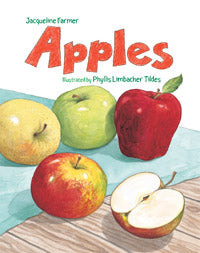Apples

Jacqueline Farmer, author
Jacqueline Farmer is the author of Pumpkins. She also supports Greensboro Beautiful, a program dedicated to tree replacement and environmental cleanup. She lives in Greensboro, North Carolina.
Read more about Jacqueline.
Phyllis Limbacher Tildes, illustrator
Phyllis Limbacher Tildes is the author and illustrator of many children's books, including Animals Black and White, Eye Guess, and Will You Be Mine?
Read more about Phyllis.
- Bank Street College of Education Best Books of the Year
- A Chicago Public Library Best of the Best Book
Booklist
The author and illustrator of Pumpkins (2004) turn their focus to apples in this informative picture book. In a text that covers how "the most popular fruit in the United States" is grown and harvested, Farmer delves into both basic botany - that parts of a flower; how pollination occurs - and more advanced concepts, such as grafting. Children encountering plant science for the first time will need help puzzling through the challenging concepts and vocabulary; photosynthesis, for example, is alluded to but not fully explained. Later spreads offer more accessible overview of apple varieties (pictured in a handsome, illustrated chart), nutrition, and historical significance. The watercolor-and-pencil artwork includes helpful, labeled diagrams as well as multicultural apple lovers, picking, eating, and enjoying the fruit, in the past and today. A recipe for apple pie and list of more apple facts close this solid choice for science units. Pair this with Betsy's Maestro's How Do Apples Grow? (1991) and Gail Gibbons' Apples (2000).
School Library Journal
Farmer provides a wealth of information here. The process of grafting is clearly explained, as are the differences between apple juice and cider, the nutritional value of the popular fruit, and the apple in history and legend. A handy chart detailing the various kinds of apples and their appropriate uses is included, as is a page of facts and records and a recipe for apple pie. Watercolor illustrations feature a multicultural cast of smiling children. The pictures accurately reflect the text and are attractive, although a bit stiff. Libraries owning Gail Gibbons’s Apples (Holiday House, 2000) will still find this book useful for supporting those fall/apple units.
Curriculum Connections
Jacqueline Farmer’s Applesprovides a more detailed look at a fruit that is “pretty to look at and a treat to eat.” The text gets to the core of the subject, delving into such topics as grafting and cross-pollination, nutritional value, cultivation history, and even some apple lore. Easy-to-understand explanations written in a conversational tone and warm watercolor paintings keep this packed-with-facts treatment accessible to young readers.
School Library Journal's Focus on Food
Conversational text and warm-hued watercolors present a bounty of facts about theses American favorites, clearly describing the cultivation and harvesting, uses, and history of each fruit. From a clear explanation of grafting apples to a lively recounting of why people carve pumpkins, these books will inform and delight young readers.
Paperback
ISBN: 978-1-57091-694-6
E-book PDF
ISBN: 978-1-60734-020-1
Ages: 5-8
Page count: 32
8 1/2 x 11





